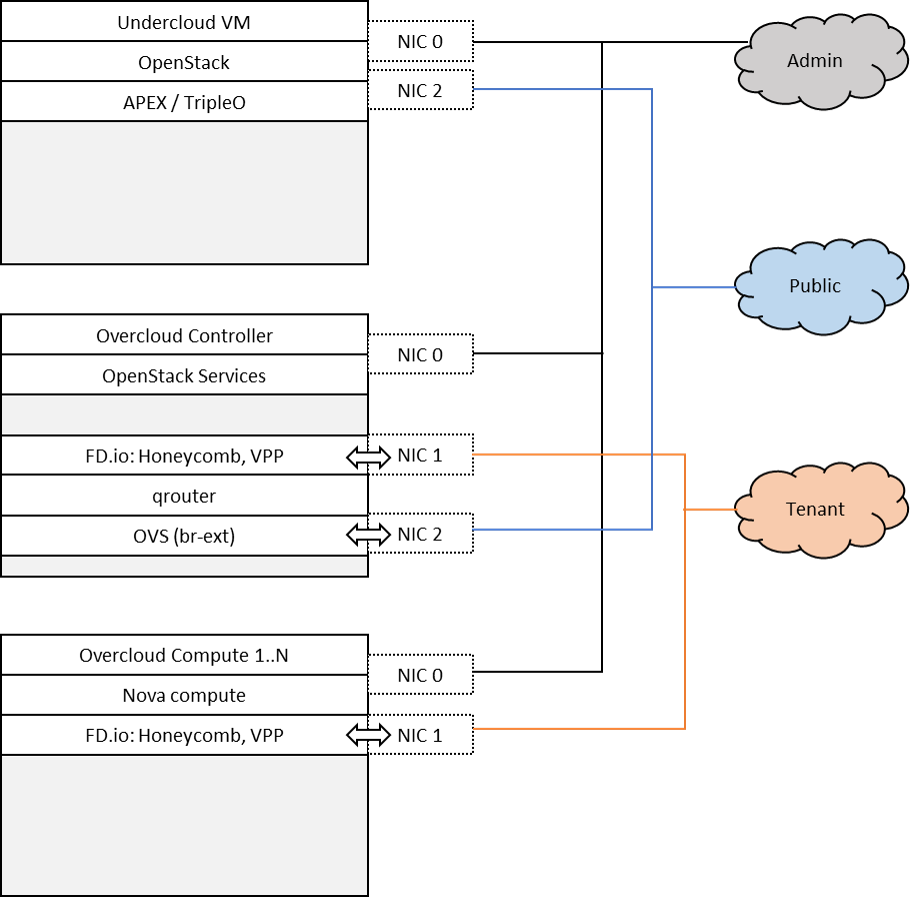Fast Data Stacks Scenario: os-nosdn-fdio-noha Overview and Description¶
Scenario: “OpenStack - FD.io” (apex-os-nosdn-fdio-noha) is a scenario developed as part of the FastDataStacks OPNFV project.
1. Scenario: “OpenStack - FD.io”¶
Scenario: apex-os-nosdn-fdio-noha
“apex-os-nosdn-noha” is a scenario developed as part of the FastDataStacks OPNFV project. The main components of the “apex-os-nosdn-fdio-noha” scenario are:
- APEX (TripleO) installer (please also see APEX installer documentation)
- Openstack (in non-HA configuration)
- FD.io/VPP virtual forwarder for tenant networking
2. Introduction¶
NFV and virtualized high performance applications, such as video processing, require a “fast data stack” solution that provides both carrier grade forwarding performance, scalability and open extensibility.
A key component of any NFV solution is the virtual forwarder, which needs to be a feature rich, high performance, highly scale virtual switch-router. It needs to leverage hardware accelerators when available and run in user space. In addition, it should be modular and easily extensible. The Vector Packet Processor (VPP) supplied by the FD.io project meets these needs, in that it offers a highly scalable, high performance and easily extensible software forwarder that entirely runs in user space.
The “Openstack - FD.io/VPP” scenario provides the capability to realize a set of use-cases relevant to the deployment of NFV nodes instantiated by means of an Openstack orchestration system on FD.io/VPP enabled compute nodes.
A deployment of the “apex-os-nosdn-fdio-noha” scenario consists of 3 or more servers:
- 1 Jumphost hosting the APEX installer - running the Undercloud
- 1 Controlhost, which runs the Overcloud and Openstack services
- 1 or more Computehosts

Tenant networking leverages FD.io/VPP. Open VSwitch (OVS) is used for all other connectivity, in particular the connectivity to public networking / the Internet (i.e. br-ext) is performed via OVS as in any standard OpenStack deployment. A VPP management agent is used to setup and manage layer 2 networking for the scenario. Neutron ML2 plugin is configured to use the ML2-VPP networking mechanism driver. Tenant networking can either leverage VLANs or plain interfaces. Layer 3 connectivity for a tenant network is provided centrally via qrouter on the control node. As in a standard OpenStack deployment, the Layer3 agent configures the qrouter and associated rulesets for security (security groups) and NAT (floating IPs). Public IP network connectivity for a tenant network is provided by interconnecting the VPP-based bridge domain representing the tenant network to qrouter using a tap interface. The setup is depicted below:
2.1. Features of the scenario¶
Main features of the “apex-os-odl_l2-fdio-noha” scenario:
- Automated installation using the APEX installer
- Fast and scalable tenant networking using FD.io/VPP as forwarder
- Layer 2 networking using VLANs, managed and controlled through the VPP ML2 plugin
- Layer 3 connectivitiy for tenant networks supplied centrally on the Control node through standard OpenStack mechanisms. All layer 3 features apply, including floating IPs (i.e. NAT) and security groups
- DHCP server for tenant instances provided using the standard OpenStack dnsmasq server
2.2. Networking in this scenario using VPP¶
The apex-os-nosdn-fdio-noha scenario combines components from two key open source projects: OpenStack and Fast Data (FD.io). In order to make Fast Data (FD.io) networking available to this scenario, an ML2 mechanism driver and a light-weight control plane agent for VPP forwarder has been created. For details see also https://github.com/naveenjoy/networking-vpp/
Networking-vpp provides a Neutron ML2 mechanism driver to bring the advantages of VPP to OpenStack deployments.It uses an etcd cluster on the control node to keep track of the compute nodes, agent state and port bindings/unbindings.
It’s been written to be as simple and readable as possible, which means it’s naive; the aim was not to write the most efficient mechanism driver ever from right out of the gate, but to write something simple and understandable and see how well it works and what needs to be changed.
As a general rule, everything was implemented in the simplest way, for two reasons: one is that one sees working results the quickes, and the other is that it’s much easier to replace a simple system with a more complex one than it is to change a complex one. The current design will change, but the one that’s there at the moment is small and easy to read, even if it makes you pull faces when you read it.
3. Scenario Configuration¶
To enable the “apex-os-nosdn-fdio-noha” scenario check the appropriate settings in the APEX configuration files. Those are typically found in /etc/opnfv-apex.
File “deploy_settings.yaml” choose opendaylight as controller with version “boron” and enable vpp as forwarder:
global_params:
ha_enabled: false
deploy_options:
sdn_controller: false
sdn_l3: false
tacker: false
congress: false
sfc: false
vpn: false
vpp: true
4. Validated deployment environments¶
The “os-odl_l2-fdio-noha” scenario has been deployed and tested on the following sets of hardware:
- Linux Foundation lab (Chassis: Cisco UCS-B-5108 blade server, NICs: 8 external / 32 internal 10GE ports, RAM: 32G (4 x 8GB DDR4-2133-MHz RDIMM/PC4-17000/single rank/x4/1.2v), CPU: 3.50 GHz E5-2637 v3/135W 4C/15MB Cache/DDR4 2133MHz Disk: 1.2 TB 6G SAS 10K rpm SFF HDD) see also https://wiki.opnfv.org/display/pharos/Lflab+Hosting
- Cisco internal development labs (UCS-B and UCS-C)
5. Limitations, Issues and Workarounds¶
For specific information on limitations and issues, please refer to the FastDataStacks (FDS) release notes.
6. References¶
- FastDataStacks OPNFV project wiki: https://wiki.opnfv.org/display/fds
- Fast Data (FD.io): https://fd.io/
- FD.io Vector Packet Processor (VPP): https://wiki.fd.io/view/VPP
- ML2 VPP mechanisms driver: https://github.com/naveenjoy/networking-vpp/
- OPNFV Colorado release - more information: http://www.opnfv.org/colorado
